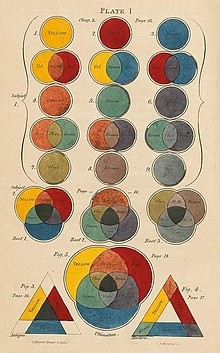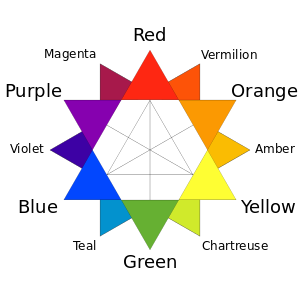Secondary color
This article has multiple issues. Please help improve it or discuss these issues on the talk page. (Learn how and when to remove these template messages)
|

A secondary color is a
Overview
Primary color
In
Secondary color
A secondary color is an even mixture of two primary colors. For a given color model, secondary colors have no special meaning, but are useful when comparing additive and subtractive color models.
Intermediate color
An intermediate color is any mixture of a secondary and a primary color. They are often visualized as even mixtures, but intermediate colors can arise from any mixture proportion. Therefore any color that is not a secondary or primary color is an intermediate color.
Tertiary color
Tertiary color has two common, conflicting definitions, depending on context.
In traditional color theory, which applies mostly to practical painting, a tertiary color is an even mixture between two secondary colors, i.e. a mixture of three primaries in 1:2:1 proportion. This definition is used by color theorists, such as Moses Harris[1] and Josef Albers.[2] The result is approximately a less saturated form of the dominant primary color of the mixture. Under this definition, a color model has 3 tertiary colors.
More recently, an alternative definition has emerged that is more applicable to digital media, where a tertiary color is an intermediate color resulting from an even mixture of a primary and a secondary color, i.e. a mixture of the primaries in 3:1:0 proportion. The result yields a maximum saturation for a given hue. Under this definition, a color model has 6 tertiary colors.
Quaternary color
A quaternary color is a seldom-used descriptor that is the conceptual extension of a tertiary color. Quaternary colors have no special use or status in color theory or color science.
Under the traditional definition, a quaternary color is the even mixture of two tertiary colors, as demonstrated by Charles Hayter. These quaternary colors have contributions from all three primaries in 3-3-2 proportions, so are very desaturated (even mixtures of three primaries gives a neutral color: zero saturation). Under this definition, a color model has 3 quaternary colors.
Under the modern definition, a quaternary color is the even mixture of a tertiary color with either a secondary or primary color. Quaternary colors are sometimes given a maximum saturation for their hue. Under this definition, a color model has 12 quaternary colors.
RGB and CMYK

The
| red | (●) | + | green | (●) | = | yellow | (●) |
| green | (●) | + | blue | (●) | = | cyan | (●) |
| blue | (●) | + | red | (●) | = | magenta | (●) |
The
| cyan | (●) | + | magenta | (●) | = | blue | (●) |
| magenta | (●) | + | yellow | (●) | = | red | (●) |
| yellow | (●) | + | cyan | (●) | = | green | (●) |
Under the modern definition, the 6 tertiary colors are conceptually equivalent between the color models, and can be described by the even combinations of a primary and a secondary color:
| red | (●) | + | yellow | (●) | = | orange | (●) |
| yellow | (●) | + | green | (●) | = | chartreuse | (●) |
| green | (●) | + | cyan | (●) | = | spring green
|
(●) |
| cyan | (●) | + | blue | (●) | = | azure | (●) |
| blue | (●) | + | magenta | (●) | = | violet | (●) |
| magenta | (●) | + | red | (●) | = | rose | (●) |
A color model is a conceptual model and does not have specifically defined primary colors. A color space based on the RGB color model, most commonly sRGB, has defined primaries and can be used to visualize the color mixing and yield approximate tertiary colors. Also note that the color terms applied to tertiary and quaternary colors are not well-defined.
|
RYB color model

RYB is a
| red | (●) | + | yellow | (●) | = | orange
|
(●) |
| yellow | (●) | + | blue | (●) | = | green | (●) |
| blue | (●) | + | red | (●) | = | purple | (●) |
Under the modern definition (as even combinations of a primary and a secondary color), tertiary colors are typically named by combining the names of the adjacent primary and secondary color.
| red | (●) | + | orange | (●) | = | red-orange
|
(●) | ~ | vermilion |
| orange | (●) | + | yellow | (●) | = | yellow-orange[5]
|
(●) | ~ | amber |
| yellow | (●) | + | green | (●) | = | yellow-green
|
(●) | ~ | chartreuse |
| green | (●) | + | blue | (●) | = | blue-green[5] | (●) | ~ | teal |
| blue | (●) | + | purple | (●) | = | blue-purple | (●) | ~ | violet |
| purple | (●) | + | red | (●) | = | red-purple
|
(●) | ~ | magenta |
Approximate colors and color names are given for the tertiary and quaternary colors. However, the names for the twelve quaternary colors are quite variable, and defined here only as an approximation.
|
Under the traditional definition, there are three tertiary colors, approximately named russet (orange–purple), slate (purple–green), and citron (green–orange), with the corresponding three quaternary colors plum (russet–slate), sage (slate–citron), buff (citron–russet) (with olive sometimes used for either slate or citron).[7][8] In every level of mixing, saturation of the resultant decreases and mixing two quaternary colors approaches gray.
The RYB color terminology outlined above and in the color samples shown below is ultimately derived from the 1835 book Chromatography, an analysis of the RYB color wheel by George Field, a chemist who specialized in pigments and dyes.[9]
|
|
|
|
See also
- Color theory
- Color wheel
- List of colors
- Primary color
References
- ^ Moses Harris (1766). The Natural System of Colours. Laidler.
- ISBN 0-300-01846-0.
- ISBN 0-06-273717-1.
- ISBN 0-8230-3259-0.
- ^ ISBN 0-240-80187-3.
- ^ a b RGB approximations of RYB tertiary colors, using cubic interpolation."RYB RGB conversion". Archived from the original on 2013-06-28. Retrieved 2012-12-29. The colors are paler than a simple mixture of paints would produce. Pure tertiary colors would be darker still.
- ^ William J. Miskella, 1928, Practical Color Simplified: A Handbook on Lacquering, Enameling, Coloring And Painting, pp
- ^ John Lemos, 1920, "Color Charts for the School Room", in School Arts, vol. 19, pp 580–584
- ^ Maerz and Paul (1930). A Dictionary of Color. New York. p. 154.
{{cite book}}: CS1 maint: location missing publisher (link)

